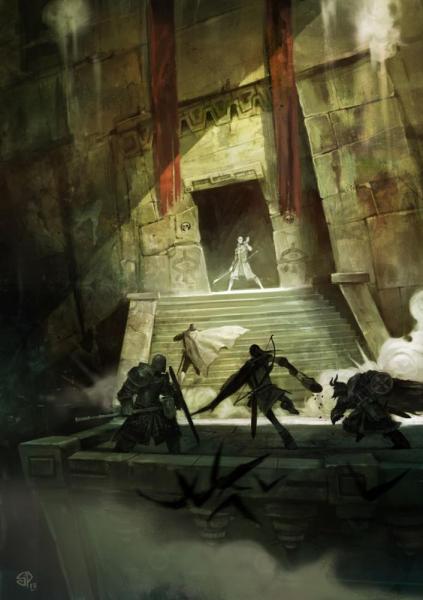These last couple of days I’ve been thinking about and rereading the rules for high level characters and ruling over domains in the Expert and Companion rules. Domain play has always been something of an elusive beast that few people seem to have any real experience with. Got there once but didn’t stay with it long seems to be the most common statement.
When you look at the Cook Expert rules (1981), domain play is almost completely absent. It tells you that characters at 9th level can become rulers of a domain, tells the GM to handwave a monthly tax income, and has a half page of price lists for constructing a castle. But it doesn’t really go into what play as a ruler would be like.
In the Companion set, a lot more ink has been spilled about it. There’s lots and lots of rules for management and accounting. But as far as I am able to tell, there still is no real guidance of any kind what players would actually be doing in play. Doing the accounting for a domain and occasionally fixing the mess caused by raiders or disasters? How would this be appealing to players who so far have been exploring exotic places, navigated deadly dungeons, and had dealing with monsters and evil sorcerers?
It could be a fun game to some people, but doesn’t seem to mesh at all with what D&D has been up to that point. And much more importantly, it’s not a group activity. One player rules a domain and makes all the descisions for it. If all the players have their own separate domains, how would they be playing together? You can of course play a game of warlords, but that would be a competitive game, not a cooperative one. And a group of characters who have been working together for years wouldn’t suddenly become rivals and send their armies against each other. The only practical way I can see for having PCs become rulers over domains would be to have them retired from play and have them occasionally appear as quest giver NPCs played by their old player. Who would then be playing a new adventuring character to actually go on that adventure. If you have a large scale campaign with dozens of players and multiple GMs I could see that working for a handful of high level characters. But this simply isn’t the reality of how D&D is played. I wouldn’t be surprised if the number of such groups that still exists today could be counted on the fingers of one hand. If there even are any.
One argument for domain play in a campaign with more Sword & Sorcery leaning that occasionally comes up is that Conan was a king. Kane was a sorcerer-warlord and Elric was an emperor. But the important part is that their stories are never about ruling and managing their domains. Sword & Sorcery tales about rulers are always about leaving the court with a sword in hand and fighting monsters. If you want to emulate the high level adventures of popular Sword & Sorcery heroes then domain management rules are completely irrelevant and out of place.
Occasionally there are big battles between armies, but even then those stories are not about being a field commander. It’s always about personally going after the enemy commander or pulling awesome stunts to destroy the enemy forces without having your own troops stab them dead one by one. Mass combat isn’t something that happens in Sword & Sorcery either. What you get is raids with a group of maybe up to a dozen people. Which would be a group of PCs and their henchmen.
So I’ve come to the descision that the high level elements of the Ancient Lands setting will simply assume that there is no such thing as domain play. Taking control of a stronghold and gathering followers will simply be down to players actually fortifying a place and talking to people. It may be done at any level and take whatever scale seems appropriate for a given situation. But for all intents and purposes characters will pretty much stop to advance after 9th level and only gain small increases in hit points at a very slow pace from their continued adventures, plus skill points for specialists and spell points for witches. (In my War Cry of the Flame Princess rules fighters reach maximum attack bonus and witches maximum spell level at 9th level, and scouts maximum Bushcraft and Stealth skills at 10th level.) I only ever had two campaigns reach 11th level and that was both in 3rd edition which has pretty fast level progression. So chances are pretty high I won’t ever see a 10th level character in the Ancient Lands anyway.

 This thing can be played.
This thing can be played.